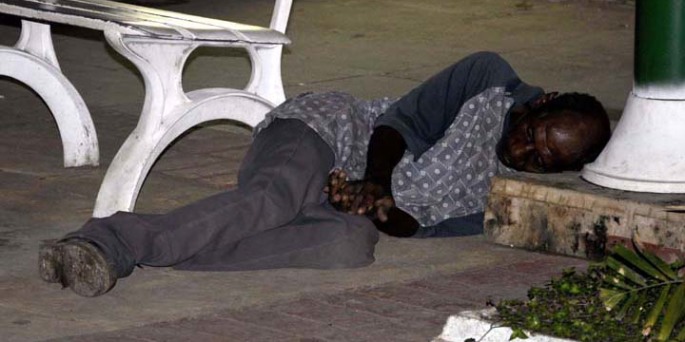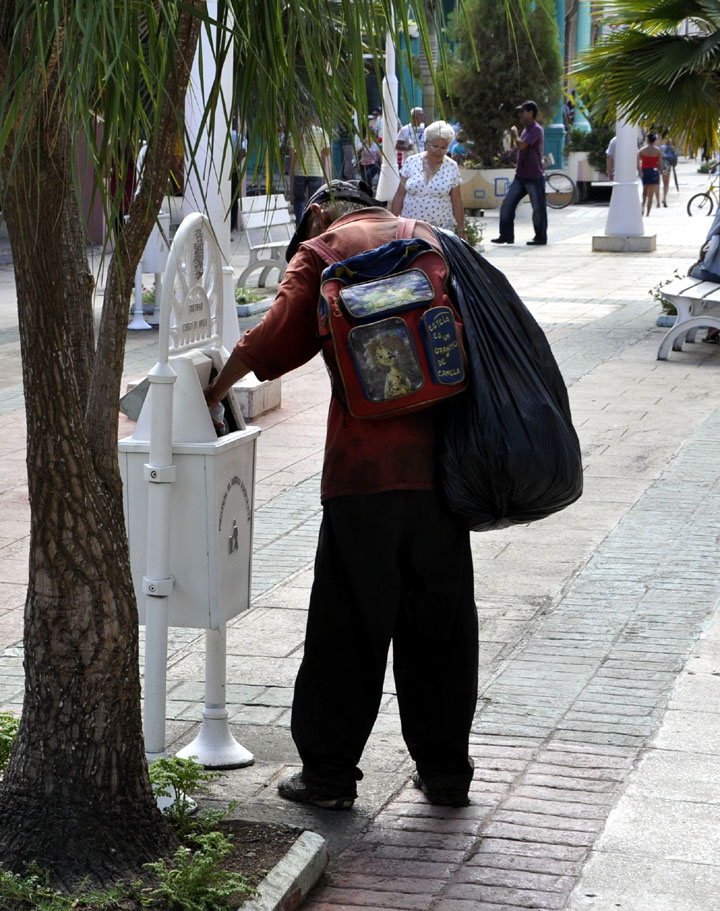
‘Deambulantes’: A major issue
CIEGO DE AVILA.- According to a recent document addressed to the chairmen of the provincial Administrative Councils and the Isle of Youth by the minister of Labor and Social Security [Margarita González Fernández], the problem of the so-called “deambulantes” [roamers, wanderers] in Cuba is more complex than heretofore reported.
In fact, little about this topic has appeared until now in the Cuban press; barely a handful of reports or notes that do not reflect the true extent of this issue.
Those reports list at least 1,108 persons in this type of situation, according to the 2012 Census, which devoted one day to count them countrywide. From that number, 958 are men, 150 are women; 641 range in age between 16 and 59; 467 are 60 years old or older.
This only confirms what the streets in the main cities of Cuba have been shouting for a couple of decades, maybe three. Despite the health-care and social security coverage promoted by the Cuban social system, there is a need for more specific and effective policies toward groups and persons who require better shelter.
Actually, the word “deambulante” is a euphemism that not always covers the multiplicity of behaviors reported. “Deambulante” describes people’s erratic and wandering ways, that fact that they sleep on park benches or entrance hallways. But they could also be called “sin techo” [homeless] because in most cases they don’t have a roof over their heads, period.
Or “mendigos” [mendicants], because they often ask for money. Or “pordioseros” [beggars, paupers], a word that says more about the observer than the observed but that reflects these people’s filthiness, even their madness.
It’s enough to look into their eyes to guess at the tragedy in their lives, never mind their dirty, foul-smelling and tattered clothes or the bottle of cheap rum that some carry with them.
Government functionaries in Ciego de Ávila province say that the Prevention Commission, in charge of providing prophylaxis and care to the “deambulantes,” operates countrywide.
But if there are any doubts of the Commission’s scant effectiveness, the [Labor Ministry’s] report concludes that “the joint work of the organizations and institutions, both in community prevention and in the care to people with that kind of behavior, is deficient.”
At the inception of the Prevention Commission, its members included the municipal Administration Councils, the mass organizations, the directorates of Health, Labor and Social Security, the police, the Prosecutor’s Office, and other institutions.
The Commission even had a presence in the People’s Council, where its members met once a week and coordinated family dynamics, because the “deambulantes” are not nobody’s children, though they may seem to be. They are the children, siblings and parents who nobody wanted.
Bums? Sickos?
There’s always someone who, from the shady side of the street, with the authority of someone who has no “deambulantes” in his family, insists that these people are bums who don’t want to work and pretend to be mad in order to live at others’ expense.
However, field studies by Ángela Ajate García, chief of Social Assistance at the Municipal Health Directorate of Ciego de Ávila, reveal something else.
According to the specialist, they are mostly people with mental illness, addicted to alcohol or drugs; a large percentage of them are elderly people. In her years as social worker, Ajate has had many experiences with them, including riding a bus to the eastern provinces with 73 “deambulantes,” including three who had escaped from the Camagüey Psychiatric Hospital.
Ajate explains that, when the “deambulante” is over the age of 60, he or she can be admitted to a home for the elderly, so long as he does not have an underlying psychiatric illness.
Whenever applicable, they are given priority, in accordance with Joint Resolution No. 1 of the Ministry of Health and the State Committee on Labor and Social Security, which regulates the priorities for the granting of social assistance.
However, for those under 60, there are no concrete solutions.
“Sometimes, they seem to be very old because of their physical deterioration and their living conditions, but they’re not yet 60,” says Ajate.
So far this year, about 10 “deambulantes” have been admitted into homes for the elderly, daytime senior centers, or the Nguyen Van Troi Psychiatric Hospital in Ciego de Ávila.
The program of care for the elderly (at least in the capital city of this central province) is limited by the structural conditions of several of the protective institutions. This does not generate a promising outlook in a municipality where at present some 40 people are roaming the streets.
There is no law in Cuba that forbids citizens to roam the streets, or ask for money, or besiege the tourists, something that is often seen. Nor is there a law that obligates families to take care of their members. There is not even a law that regulates and integrates the handling of “deambulantes.”
As explained by specialists at the Provincial Prosecutor’s Office in Ciego de Ávila, Article 275 of the Cuban Penal Code refers to the obligations of parents to their children until they reach adulthood (the age of 18).
It also establishes the care and guardianship of elderly, ailing or disabled persons, but — and here’s the twist — only if there is a Court ruling granting their relatives custody over them. Siblings, grandchildren and spouses are not obligated by law to assume responsibility for them.
Article III, Chapter 4 of the Cuban Constitution, on the subject of the family, says that “the parents have the duty to feed their children and aid them in the defense of their legitimate interests,” but assigns to the children only “the obligation to respect and aid” their parents. It does not specify what that aid consists of.
The sources consulted for this article said that any citizen or institution may file suit in a case of abandonment or neglect and enforce the law. However, no such lawsuits are before the courts today.
Given the present circumstances (and others that could be cited), several specialists in Cuban law believe that our legal tools should be modified to allow for the new scenarios.
Some Cuban provinces are reporting centers that specialize in the classification and care of “deambulantes.” One such center has operated in Havana since 2002. Similar centers are reported in Bayamo and Holguín; another one was inaugurated in Las Tunas a few months ago.
By order of the Ministry of Public Health, psychiatric hospitals may not assume that role, and the homes for the elderly, the psycho-pedagogical centers and the daytime senior centers are not prepared to welcome “deambulantes” without a diagnostic.
With an elderly and impoverished population — nearly 25 percent of the Cuban population live in poverty, according to several reports — the topic of “deambulantes” or beggars or homeless people is not a minor issue about the dignity of a few persons or the appearance of some cities.
It is an expression of the need to establish clearer and more efficient policies, so society may protect the neediest with greater equity.
Photos: Edelvis Valido





